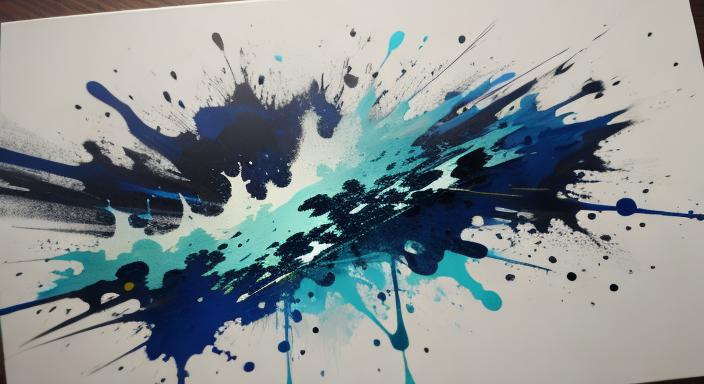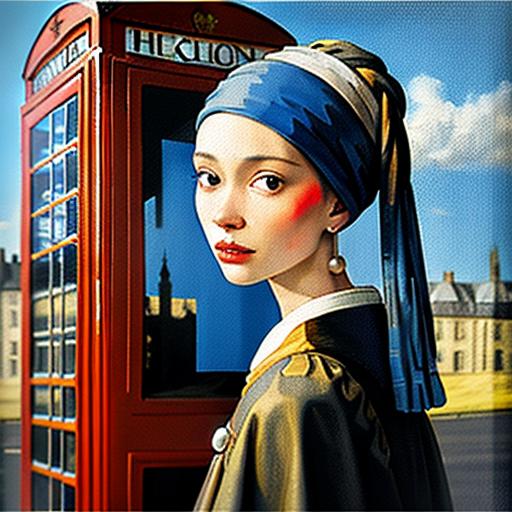Have you ever wondered why Van Gogh’s paintings exploded with color when he moved to sunny Provence? Or why Monet spent decades painting the same water garden? The answer lies in something that shapes nearly every brushstroke: location inspires artists in profound and transformative ways. From the mountains that taught early painters about scale to the bustling cities that sparked entire art movements, where an artist lives and works dramatically influences what—and how—they create.
Key Points Summary
- Physical environment directly affects an artist’s color palette, techniques, and subject matter through unique light, climate, and landscape features
- Urban centers act as creative catalysts by concentrating resources, patrons, and artistic communities that fuel innovation and movements
- Relocation can trigger radical stylistic shifts, as seen with Van Gogh, Picasso, and Hockney
- Regional landscapes shape national identity and artistic traditions, from American wilderness paintings to Japanese woodblock prints
- Cultural heritage and history of a place provide rich inspiration beyond visual elements
- Modern technology hasn’t eliminated the importance of location—it’s changed how artists document and share location-based work
What Makes Location Such a Powerful Creative Force?
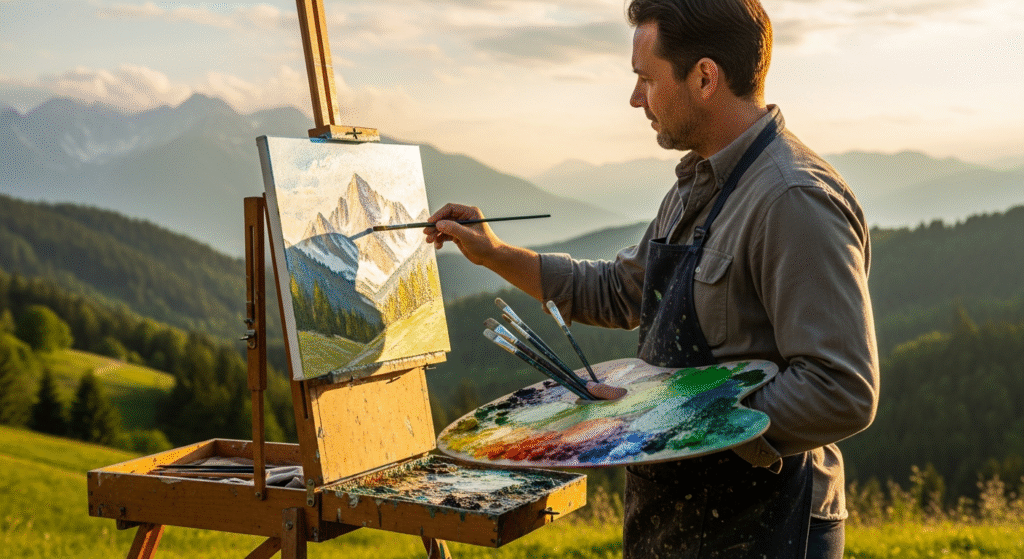
When we talk about location inspiring artists, we’re not just discussing pretty scenery. Location operates as a complex, multi-layered influence that shapes artistic vision in three fundamental ways: the physical environment, the social and cultural atmosphere, and the psychological connection an artist develops with a place.
The Three Dimensions of Location’s Influence
Physical/Environmental: Think about how different locations have completely different qualities of light. The intense Mediterranean sun that inspired Van Gogh’s yellow palette is nothing like the soft, diffused light of Northern Europe that influenced Dutch masters. Climate determines which painting mediums work best—David Hockney discovered that fast-drying acrylics were perfect for California’s sunny climate but wouldn’t have worked as well in foggy London.
Socio-Cultural/Communal: Cities like Renaissance Florence or 1920s Paris didn’t just inspire art—they made it possible. These places concentrated wealthy patrons, formal education, galleries, and communities of artists all in one spot. When Picasso moved to Paris’s bohemian Montmartre neighborhood, he didn’t just change his address; he gained access to fellow artists, collectors like Gertrude Stein, and the intellectual exchange that transformed his work.
Psychological/Spiritual: Ancient Romans called it “Genius Loci”—the spirit of a place. This is the intangible feeling a location creates, its unique atmosphere. Georgia O’Keeffe felt a deep spiritual connection to New Mexico’s high desert that went beyond its visual appearance. This psychological dimension transforms location from mere setting into artistic partner.
How Natural Landscapes Shape Artistic Vision
Mountains, oceans, deserts, and forests don’t just provide subject matter—they actively teach artists how to see and what to express.
Mountains and Monumental Scale
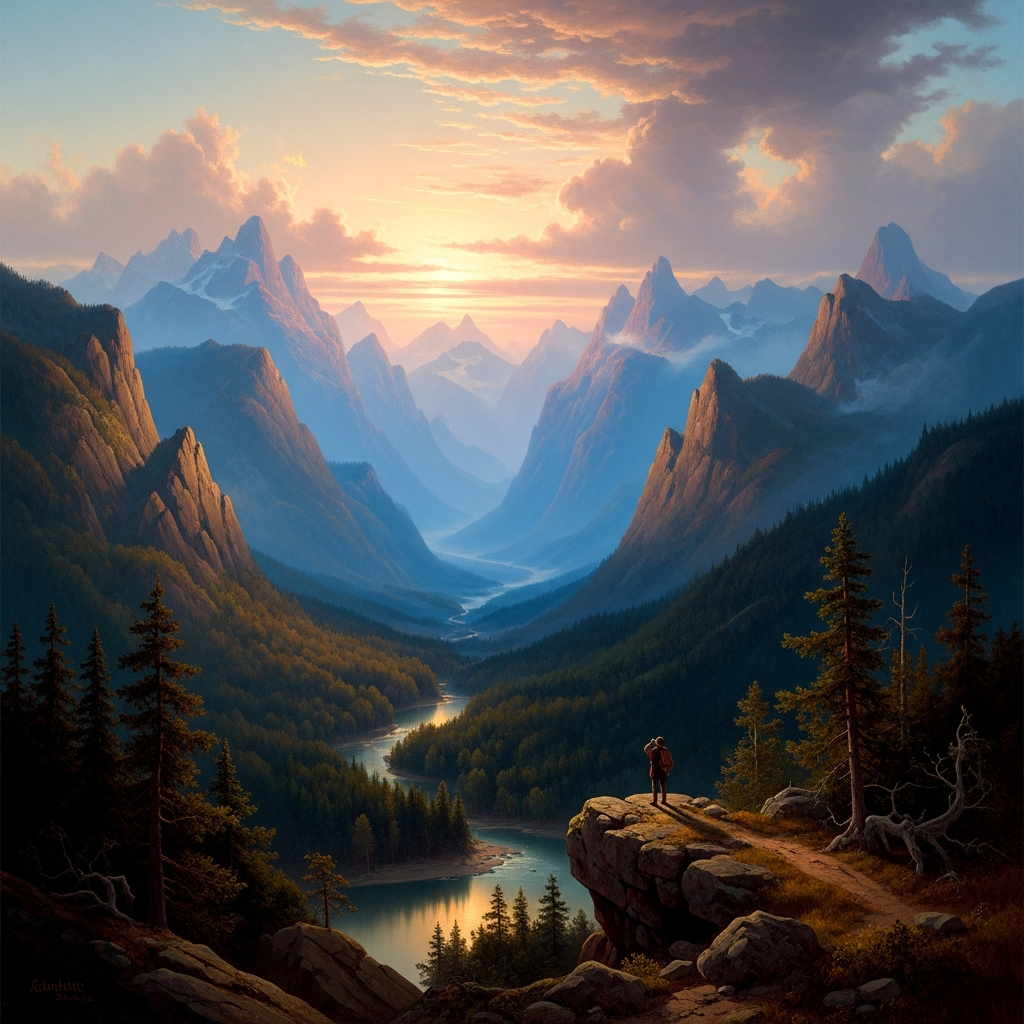
The Hudson River School artists of mid-19th century America were profoundly shaped by the Hudson River Valley and surrounding mountain ranges. Thomas Cole and his followers saw these massive landscapes as reflections of God’s grandeur. Their paintings of “epic size” reminded Americans of the “vast, untamed, and magnificent wilderness areas” in their country, helping establish an early conservation movement.
These landscape paintings weren’t just documenting scenery—they were making a political statement about American identity during westward expansion and the establishment of national parks.
Deserts and Essential Forms
When Georgia O’Keeffe first encountered New Mexico’s high desert, she found her artistic home. The location inspired her to create paintings characterized by:
- Enlarged, abstracted forms: Flowers and bones became monumental
- Minimalist aesthetic: The vast empty spaces naturally led to simplified compositions
- Purified color palette: Desert light revealed essential hues—pure blues, blacks, and ochres
- Spiritual subject matter: The desert’s silence and space resonated with her inner vision
O’Keeffe painted specific landmarks repeatedly, including Cerro Pedernal mountain and “The Black Place” in the Bisti Badlands. Her painting “Black Mesa Landscape, New Mexico / Out Back of Marie’s II” (1930) reduces the landscape to elemental forms—blue peaks, black ground, and a strip of green—showing how sustained connection to one location can lead to increasingly abstract and powerful representation.
Coastal Environments and Emotional Resonance
Coastal regions offer artists the “relentless ebb and flow of the tides, the briny scent of the sea, and the dance of sunlight on the water’s surface”, creating art imbued with “fluidity, rhythm, and vibrancy.” Seascape painting appeals emotionally because it evokes serenity and reduces stress.
But modern artists use coastal locations for more than tranquility. Many contemporary artists focus on oceans to address pollution and ecological destruction, transforming location from peaceful subject to urgent environmental record.
The City as Creative Catalyst: Urban Locations That Changed Art History
While expansive landscapes inspire national identity, dense cities accelerate innovation by creating unique conditions for movement formation and radical experimentation.
Renaissance Florence: The Original Creative Hub
Renaissance Florence demonstrates how a city’s structure can revolutionize art. The Medici family’s financial power created consistent demand for sophisticated art. Social shifts—particularly the Franciscans’ emphasis on Christ’s humanity—demanded religious art that offered closer human identification.
This concentrated intellectual environment led to:
- Development of linear perspective
- Detailed anatomical studies
- Enhanced ability to reproduce the familiar world convincingly
- Humanist scholarship influencing subject matter
The city structure fostered an artistic marketplace concentrating both economic means (patronage) and intellectual demands (humanist scholarship, new religious mandates) necessary for technical revolution.
Paris: From Haussmann’s Boulevards to the School of Paris
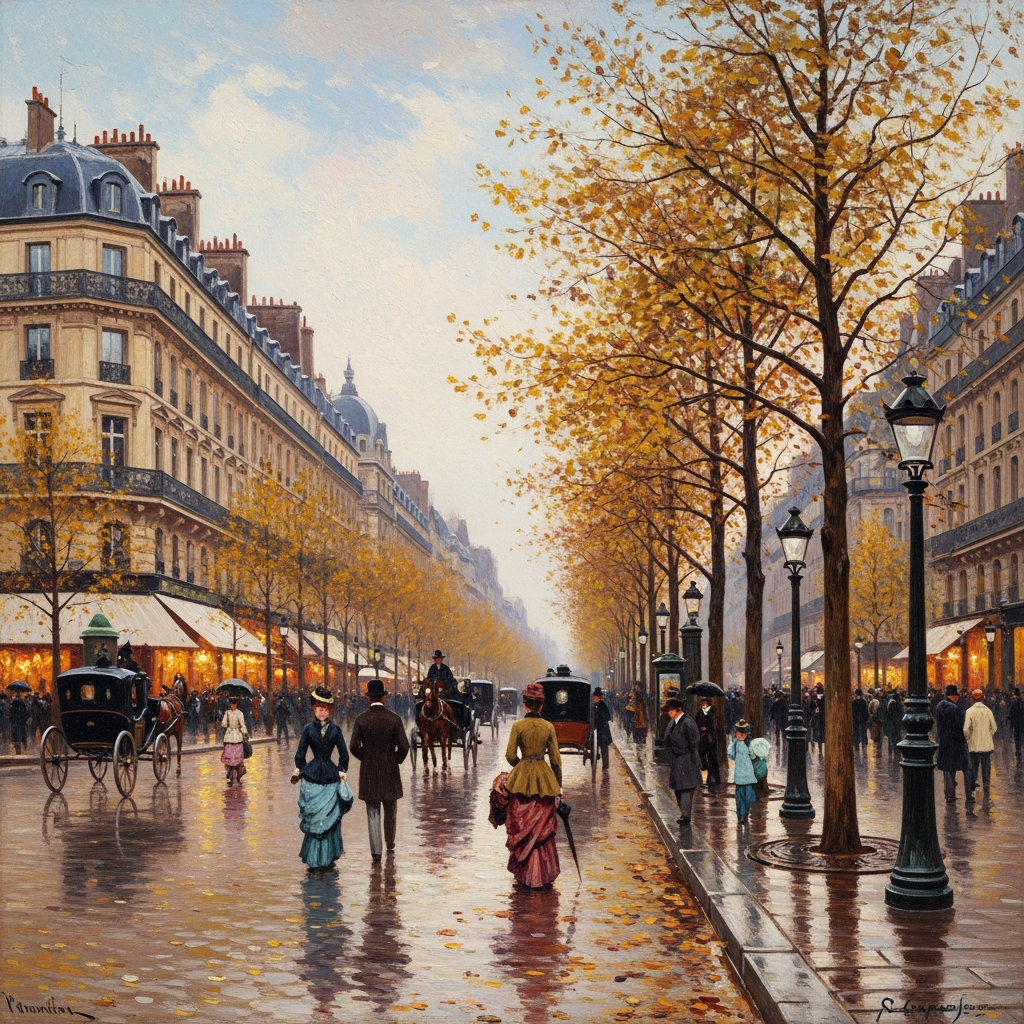
Baron Haussmann’s transformation of Paris (1853-1870) gave Impressionist artists an entirely new urban backdrop. Wide boulevards, public gardens, and modernized cityscapes became primary subjects. Gustave Caillebotte’s “Paris Street; Rainy Day” (1877) captures the geometrically modernized Place de Dublin.
The rapid expansion of French rail systems allowed artists to escape to rural locations like Fontainebleau forest, creating dual subject matter: urban modernity and rural leisure.
By the early 20th century, Paris became the acknowledged center of modern art, termed the “School of Paris.” Districts like Montmartre and Bateau-Lavoir attracted artists worldwide because affordable rent allowed dense artistic communities to form. Picasso, Modigliani, Monet, and Van Gogh could exchange ideas freely.
The success relied on combining socioeconomic factors: affordable space (supply) with wealthy patrons and dealers (demand), creating a high-density, high-output artistic marketplace sustaining radical innovation.
New York’s Post-War Ascendancy
Harlem, as a specific location in New York, was crucial for the Harlem Renaissance, creating a powerful movement of African American artistic expression. Post-World War II, New York became the new center for Abstract Expressionism and other abstract movements during the 1950s and 60s.
The concentration of galleries specializing in these movements demonstrates that defining an art movement requires necessary institutional and market infrastructure. Understanding how social media influences painters today reveals modern versions of this concentration effect.
Light, Climate, and Technical Choices: The Science of Location
Beyond cultural influence, physical environment imposes direct, measurable constraints and opportunities profoundly shaping technique, palette, and medium choice.
How Light Transforms Painting
For painters, lighting conditions are technically essential. Light sources have different color temperatures, dictating whether colors appear warmer or cooler. Light and shadow create depth and dimension while significantly affecting how surface texture renders.
Artists must master depicting:
- Direct light: Creates distinct highlights and shadows
- Indirect/ambient light: Softens contrast for natural, balanced look
- Reflected light: Bounces off surfaces, adding subtle color and tone variations
Understanding these principles is crucial for anyone learning color theory basics or working with color mixing.
Van Gogh’s Yellow Sun: How Provence Changed Everything
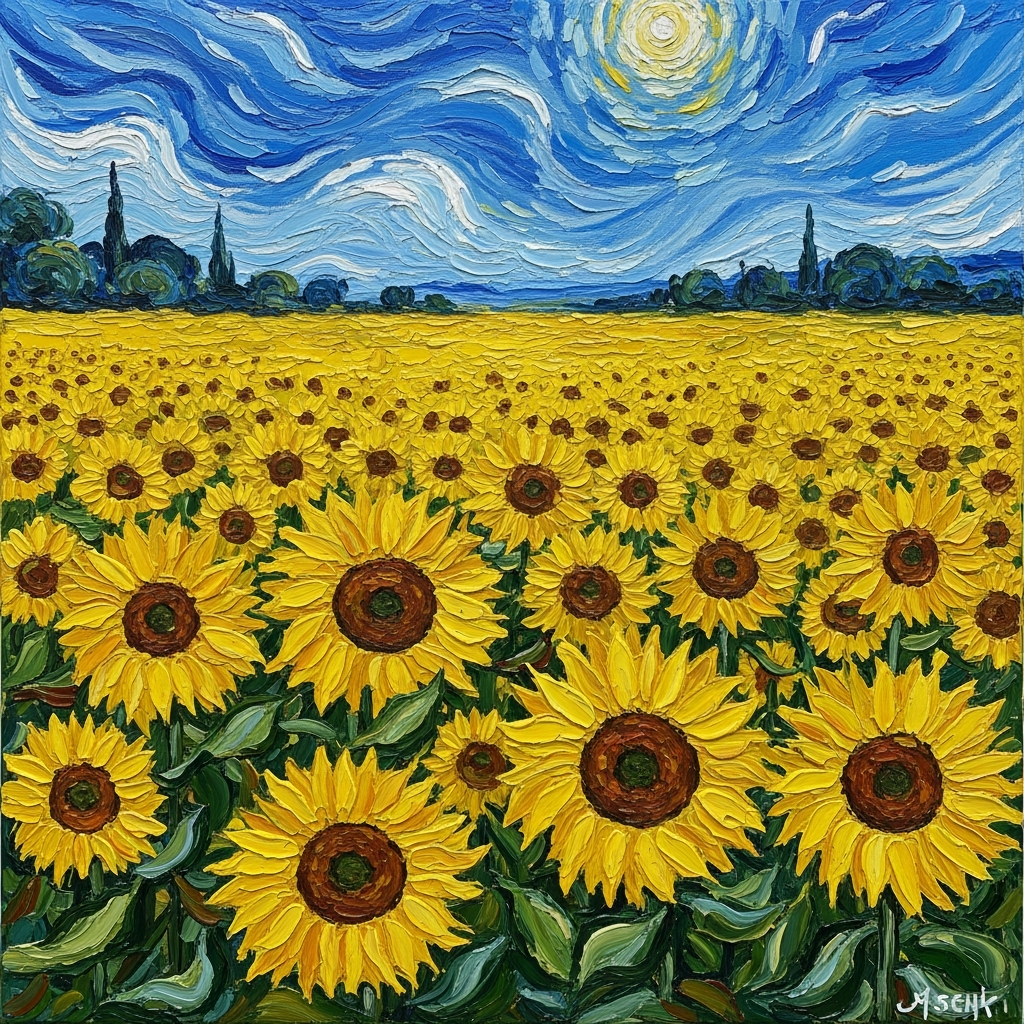
Vincent Van Gogh’s relocation to Arles, Provence precipitated dramatic chromatic change. His time there is inextricably linked to the color yellow, which dominates his paintings from that period.
Van Gogh explicitly stated he “worshipped the Provençal yellow sun and its sulphur or gold coloured light.” This intensity enabled him to finally employ “strong, unbroken colours that he had yearned for,” believing southern light was paramount for a truly modern palette.
Environmental conditions directly influenced material choices. His palette included relatively new, vivid pigments:
| Pigment | Technical Name | Characteristic |
|---|---|---|
| Cadmium Yellow | PY35 | Intense, warm yellow |
| Cobalt Blue | PB28 | Vibrant, stable blue |
| Viridian | PG18 | Rich, transparent green |
These potent contemporary pigments, combined with traditional earth pigments, realized his goal of being “the colorist as the world has never seen.”
Monet’s Obsessive Observation
Claude Monet stated: “I know very well that to really paint the sea, one must observe it every day at every hour and from the same place.” This underscores Impressionism’s core mission—capturing transient light and atmospheric effects—which demanded intense commitment to specific locations.
The stylistic ambition necessitated that location dictate observation duration and nature required for artistic mastery. Learning watercolor techniques benefits from this same principle of sustained observation.
Hockney’s California: When Climate Determines Medium
David Hockney’s 1963 relocation to California, which he described as his “promised land” due to its sun and laid-back lifestyle, directly shaped his material practice. Hockney found fast-drying acrylic paint more suitable than slow-drying oils for portraying “sun-lit, clean-contoured suburban landscapes.”
This environmental determination led to his iconic style development—large areas of flat color and graphic details—solidifying his position as a key Pop Art contributor. His famous swimming pool paintings like “A Bigger Splash” couldn’t have been painted the same way with traditional oils in a different climate.
Transformative Journeys: When Moving Creates Radical Change
The most powerful evidence for location’s inspirational force lies in cases where physical relocation served as deliberate break, resulting in radical stylistic shifts.
Picasso: From Blue Despair to Rose Community
Pablo Picasso’s journey illustrates how location acts as psychological barometer directly influencing emotional and chromatic register.
Blue Period (1901-1904): Spent intermittently in Spain and early Paris, driven partly by his friend Casagemas’s suicide, this period featured themes of loneliness, poverty, and despair rendered in “dismal range of blues.”
Rose Period (1904+): His definitive move to Montmartre’s bohemian community marked immediate psychological change. He secured dedicated patrons (Gertrude and Leo Stein), found supportive intellectual community with peers like Henri Matisse, and the result was radical transition:
- Abandoned blue palette for vivid hues including red
- Directed attention toward pleasant subjects like harlequins and carnival performers
- Gained intellectual stimulation and financial stability
- Physically removed from previous emotional desolation
Learning from Picasso’s revolutionary approach reveals how powerfully environment shapes artistic output.
Gauguin’s Tahitian Transformation
Paul Gauguin’s decision to abandon family and Europe for Tahiti was conscious search for artistic renewal rooted in perceived “primitive” culture. This relocation catalyzed profound stylistic rupture leading to his most famous Synthetist works.
The Tahitian environment inspired:
- Radical subjective color palette: Prismatic colors, golden skin tones, emerald green
- Indigenous cultural focus: Mythology and local life became subjects
- Flattened forms and bold outlines: Moving away from Impressionist techniques
- Influential legacy: Impacted subsequent movements like Fauvism
However, this work must be viewed critically—it was rooted in colonial framework, often exoticizing and appropriating indigenous life, reflecting complex and sometimes exploitative cultural dynamics in searching for the “primitive” abroad.
Stylistic Ruptures Driven by Location
| Artist | Previous Location/Style | New Location | Resulting Change | Key Elements Gained |
|---|---|---|---|---|
| Paul Gauguin | Paris / Impressionism | Tahiti | Synthetism, subjective color, flattened forms | Prismatic palette, mythological subjects, indigenous inspiration |
| David Hockney | London / Art College Abstraction | Los Angeles | Pop Art, clean lines, suburban dreamscape | Fast-drying acrylics, geometric composition, pool motifs |
| Pablo Picasso | Barcelona / Early Paris | Montmartre, Paris | Blue to Rose Period transition | Intellectual community, patrons, happier subjects |
| Vincent Van Gogh | Paris / Darker Palette | Arles, Provence | Strong unbroken colors, light intensification | Provençal yellow sun, modern palette execution |
Understanding these famous artist styles shows how dramatically location can reshape creative output.
Regional Identity: Location as Political and Cultural Statement
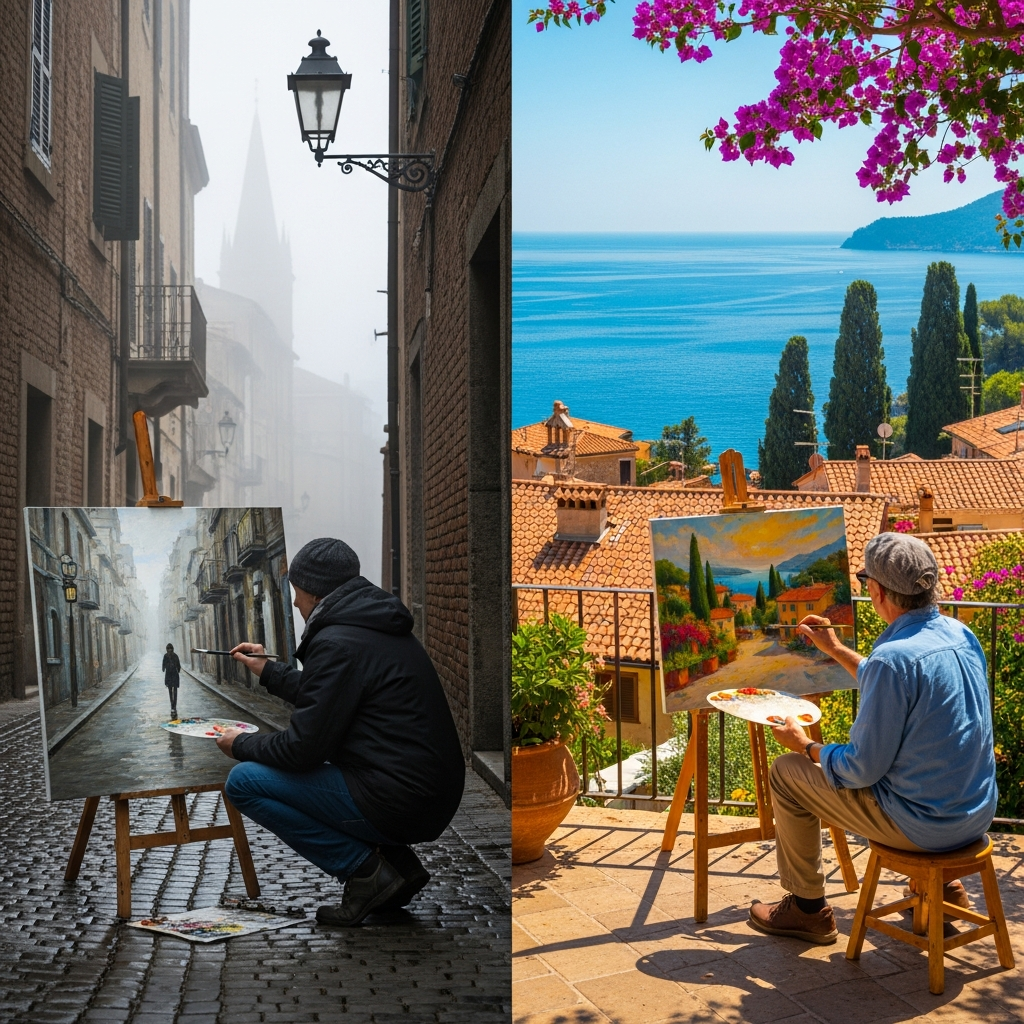
Large monumental landscapes become central to defining cultural, national, and religious identities, demonstrating location as unifying macro-subject.
American Regionalism: The Heartland as Ideology
Arising from the American Scene movement following the Great Depression, Regionalist artists focused on shunning perceived French art domination and establishing truly American identity.
Regionalism reached popularity peak between 1930 and 1935 due to conservative, traditionalist style and reassuring images of American heartland. The “Regionalist Triumvirate”—Grant Wood, Thomas Hart Benton, and John Steuart Curry—explicitly argued that solutions to urban problems and economic crisis lay in returning to rural, agricultural roots.
Their choice of rural location wasn’t merely aesthetic—it was political position, using American landscape to project specific vision of national recovery and morality. This demonstrates how exploring cultural influences in modern art reveals deeper meanings beyond surface appearance.
The Universal Language of Landscape
Location-based movements succeed partly because landscape possesses universal language transcending cultural or historical prerequisites. Images depicting forest tranquility or lake serenity offer universal emotional connection requiring no specialized knowledge.
This inherent accessibility allows location-specific art to effectively project national or communal sentiment on grand scale, ensuring widespread appreciation and relevance—a principle still relevant for contemporary painting artists.
The Built Environment: Cities as Artistic Subject and Medium
Contemporary practice increasingly treats architecture not as passive background but as primary subject, formal element, or communication means.
Architecture as Visual Language
Artists like Daniel Mullen use architecture as structural constraint and visual language. Sarah McKenzie, focusing on architecture, seeks to change how viewers see spaces they inhabit, making the often “invisible impact” of location visible.
Cities are now understood as conceptual mediums themselves. Urban environment offers resources for artists to engage with formal and informal structures exploring complex issues of power, identity, and social justice. This makes urban context critical site for contemporary artistic intervention and analysis.
Understanding composition principles helps artists frame urban subjects effectively.
Street Art and Urban Transformation
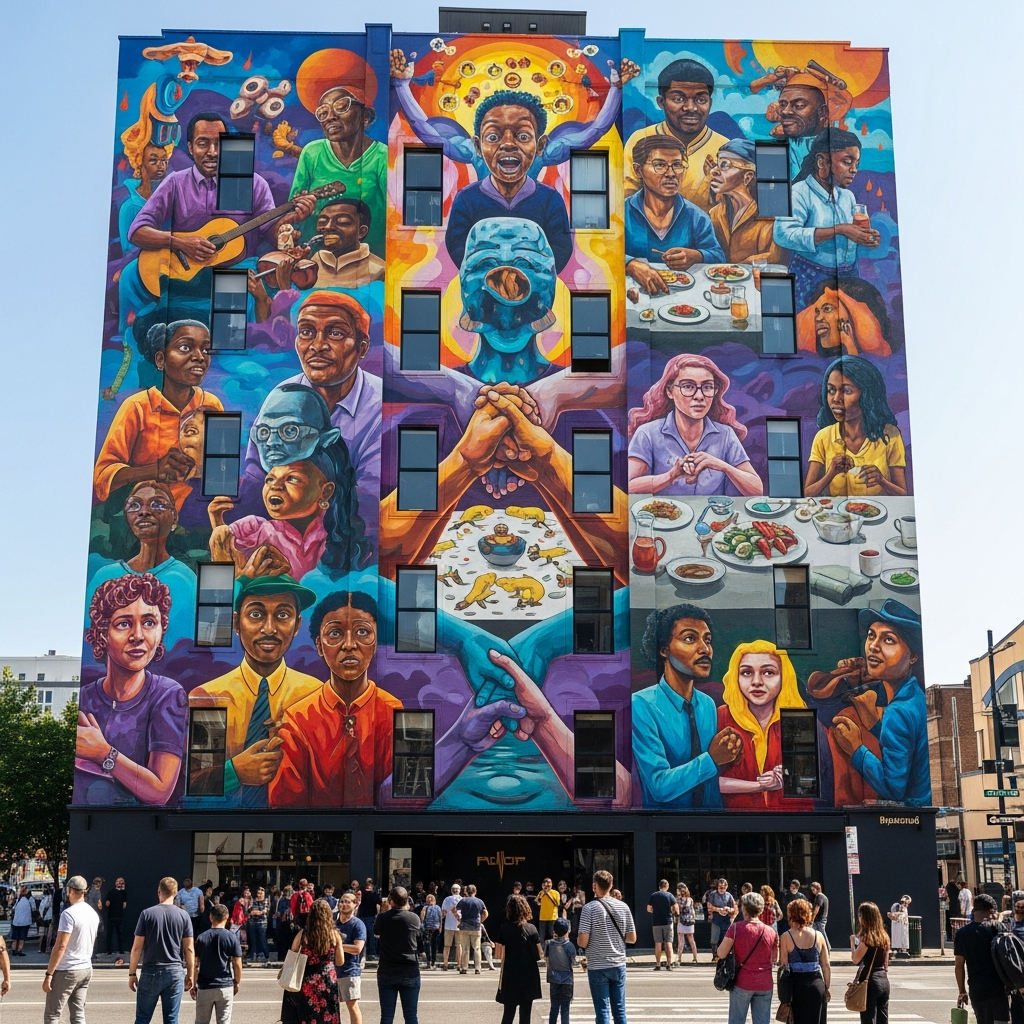
Street art exemplifies how artists actively shape location meaning. Artists like Banksy transform public spaces, adding layers of interpretation influencing how others perceive and understand places.
This art form demonstrates that location isn’t just inspiration source—it’s dynamic canvas for cultural commentary and social change.
The Digital Age: Has Technology Changed Location’s Importance?
In our contemporary era, constraints historically binding artists to specific locations—centralized patronage, specialized instruction—have diminished through globalization and technology.
Technology as Documentation Tool, Not Replacement
Digital creativity allows artists to harness online platforms, virtual galleries, and social media to share experiences and disseminate work globally. However, technology hasn’t negated need for physical location—it’s changed how location is documented and utilized.
Artists increasingly use technology to analyze and document travel influences in real-time. While less geographically constrained, physical act of travel and relocation remains transformative (as evidenced by radical stylistic shifts of Hockney and Gauguin).
Location provides essential physical experience, while technology facilitates documentation and worldwide market distribution of results. Learning how to sell art online demonstrates this modern synthesis.
Virtual Galleries and Global Reach
Virtual art galleries now allow artists anywhere to reach global audiences. Yet even with this technology, most successful artists maintain strong connections to specific physical locations that inform their work’s authenticity and uniqueness.
The art market trends show that location-specific work often commands premium prices because it offers viewers something they can’t experience elsewhere.
Historical Context: Colonialism and Location’s Complex Legacy
Location’s influence extends beyond aesthetic inspiration into contested political space where artistic styles were hybridized or forcibly adopted.
Colonial Documentation and European Influence
Early colonial artists introduced European audiences to newly discovered lands and people, with styles heavily influenced by European precedents like realism and history painting. European powers frequently imposed artistic styles (Baroque, Rococo) on colonized territories while simultaneously appropriating and exoticizing indigenous art forms.
This historical record demonstrates location isn’t just aesthetic inspiration source but contested political space. The choice and depiction of location carry inherent geopolitical meaning—something contemporary artists must acknowledge when working with culturally significant locations.
Understanding indigenous painting’s role in culture provides important context for this complex history.
Practical Applications: How Artists Can Use Location Today
Modern artists can strategically leverage location’s power while maintaining authentic voice.
Finding Your Artistic Place
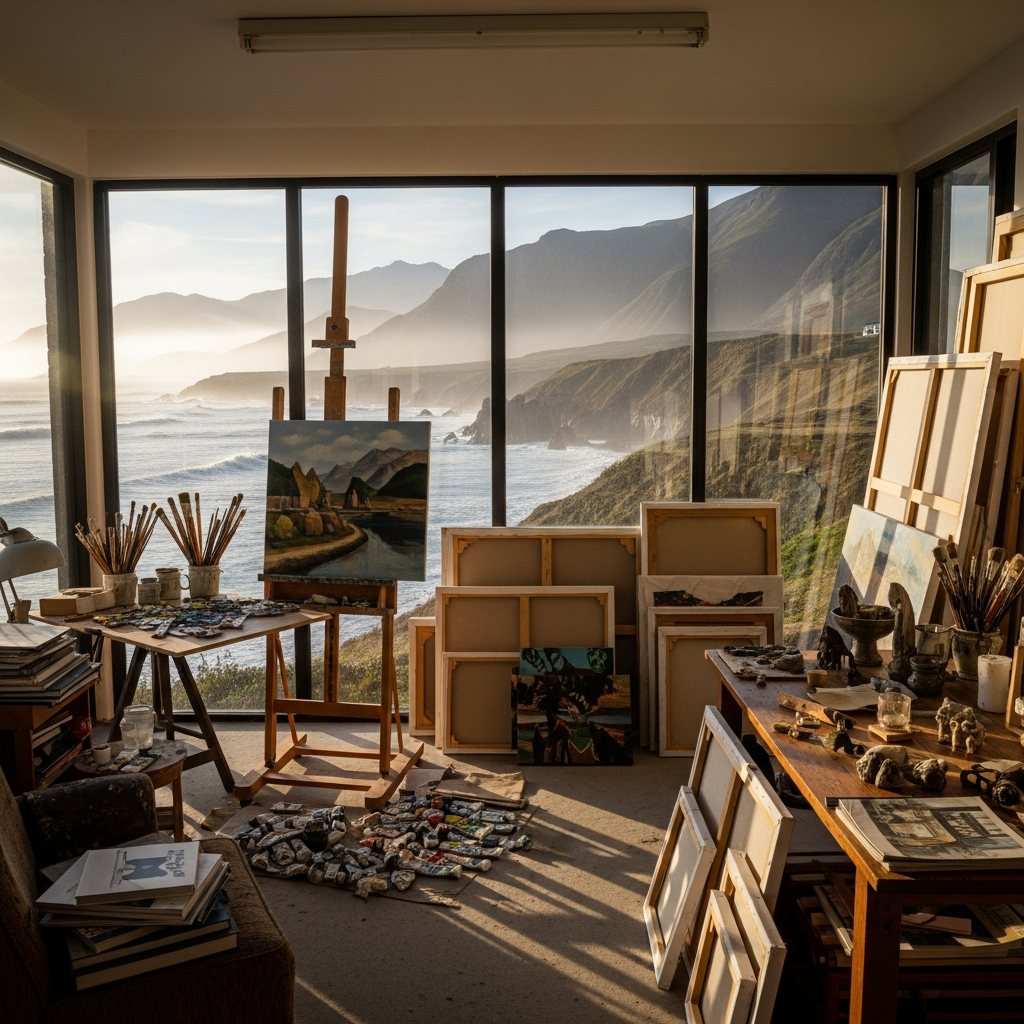
Embrace local specifics: Don’t chase exotic locations—find unique qualities in your immediate environment. Even ordinary places have extraordinary details when observed carefully. Practice plein air painting in your neighborhood to discover hidden inspiration.
Document seasonal changes: Follow Monet’s example by revisiting same location throughout seasons, observing how light and atmosphere transform familiar subjects.
Explore urban archaeology: Research your location’s history. Hope Sandrow’s Platform installation responded to East End’s Genius Loci through intensive historical research, selecting artifacts like rare photographs and bottles unearthed from grounds.
Join local artistic communities: Cities provide institutions like schools, museums, and galleries offering visual, material, spatial, and social resources vital to production. Connect with local art galleries to understand your regional art scene.
Travel intentionally: When relocating or traveling, spend extended time absorbing location’s unique characteristics. Quick visits rarely provide depth needed for meaningful artistic interpretation.
Balancing Tradition and Innovation
Every locale offers inspiration treasure trove. While drinking from these wellsprings is essential, ensure new influences complement rather than dominate your original voice. Create harmonious blend adding depth and dimension to work.
The challenge lies in embracing new surroundings while staying true to artistic identity. This balance becomes even more profound when considering how changing locations can influence your creative process. Working on finding your painting style helps maintain authenticity while incorporating new influences.
Conclusion: Location as Essential Variable in Artistic Creation
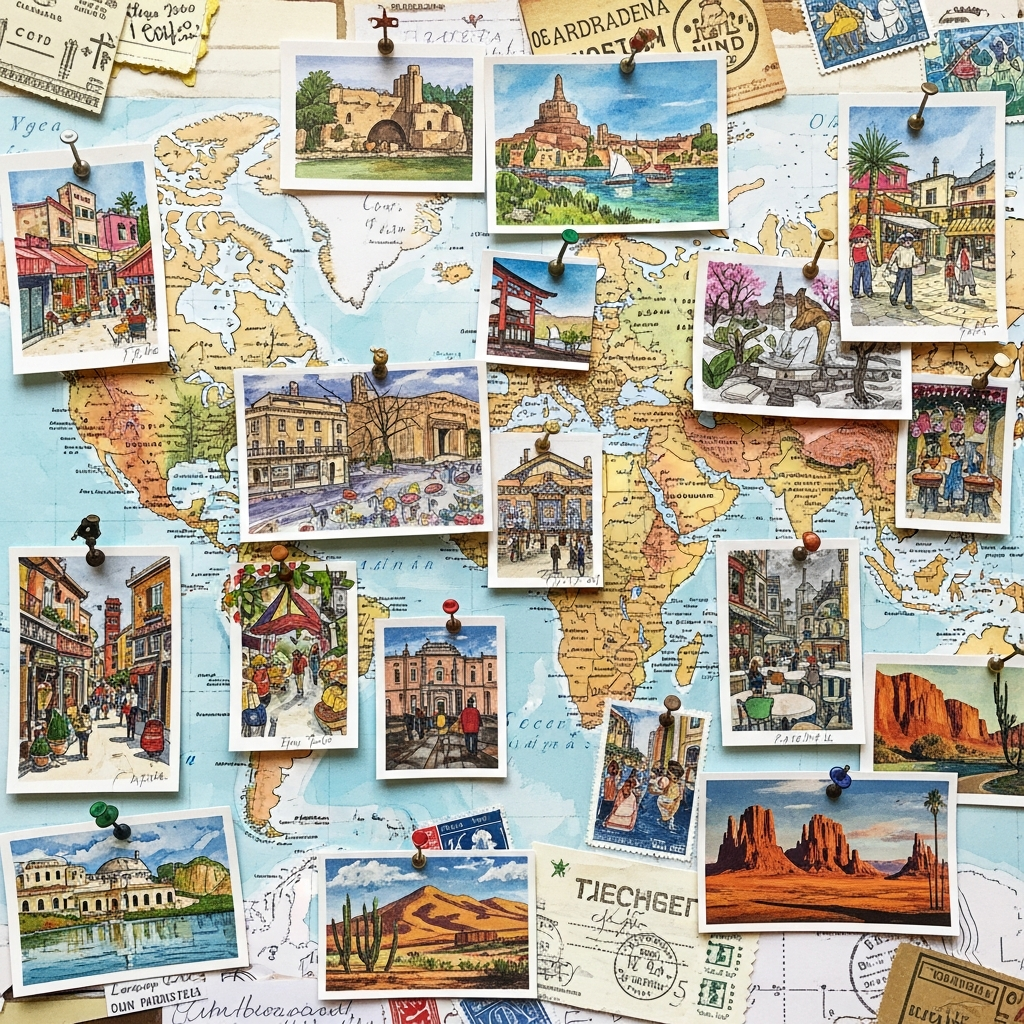
The comprehensive evidence confirms that location inspires artists as an indispensable variable in artistic production, operating on aesthetic, communal, and psychological levels simultaneously.
Location is confirmed as definitive inspiration source because it provides both subjective depth (artist’s unique psychological response and Genius Loci) and objective structure (unique light, socioeconomic resources, and built environment).
While intrinsic motivation is necessary, sustained artistic production often relies on discipline and habit. Chuck Close noted: “Inspiration is for amateurs; the rest of us just show up and get to work.” Location provides critical material and context ensuring this disciplined labor yields relevant and substantial output.
The enduring power of location is multifaceted:
- Dictates palette and medium (Environmental Aesthetic)
- Facilitates global movements (Urban Catalyst)
- Serves as canvas for political and national identity (Macro-Regionalism)
- Acts as psychological mirror enabling personal and stylistic transformations
Whether you’re just getting started with painting or you’re an experienced artist seeking new inspiration, understanding how location inspires artists can unlock new dimensions in your creative practice. From the intense sunlight of Provence to the crowded streets of Manhattan, from desert silence to coastal rhythms, the places we inhabit shape not just what we paint, but how we see the world itself.
For both historical and contemporary artists, physical, cultural, and environmental characteristics of a place are not just inspiration sources—they’re essential structural components of artistic vision itself. The question isn’t whether location inspires artists, but rather how profoundly and in how many dimensions it does so.
Frequently Asked Questions
Why do artists need to travel for inspiration?
Travel exposes artists to new light conditions, different architectural styles, unfamiliar cultural traditions, and fresh sensory experiences that challenge their established visual vocabulary. While you can create meaningful art anywhere, travel provides concentrated doses of novelty that can catalyze stylistic breakthroughs—as seen when Van Gogh moved to Arles or Hockney discovered California.
Can artists be inspired without changing locations?
Absolutely. Artists like Claude Monet spent decades painting the same garden at Giverny, finding endless inspiration in one location observed under different conditions. The key is developing deep, sustained observation practices. Many successful artists focus on their immediate environment, finding extraordinary details in ordinary places through patient, repeated study.
How does city vs. rural location affect artistic style?
Urban artists often develop styles reflecting metropolitan energy—bold lines, fragmented compositions, and subjects addressing crowding or social dynamics. Rural artists typically create more traditional, representational work emphasizing nature, precision, and contemplative quietude. However, these are tendencies, not rules—many contemporary artists deliberately subvert these expectations.
What is Genius Loci in art?
Genius Loci, Latin for “spirit of place,” refers to a location’s distinctive atmosphere or subtle energy. In art, it means the intangible qualities that make a place feel unique—not just visual appearance, but the emotional resonance, historical layers, and psychological impact. Artists responding to Genius Loci create work capturing a place’s essence beyond mere representation.
How did location influence the Impressionists?
The Impressionists were profoundly influenced by Haussmann’s modernization of Paris, which created new urban subjects like wide boulevards and public gardens. The expansion of French rail systems allowed them to paint both urban modernity and accessible rural retreats. Their entire movement centered on capturing location-specific light and atmosphere at particular moments—making location absolutely central to their artistic philosophy.
Do digital artists need physical location inspiration?
While digital artists can work anywhere and access reference images globally, many still find physical location crucial for authentic work. Being physically present in a location provides sensory experiences—sounds, smells, spatial relationships—that photographs can’t capture. However, digital artists have more flexibility to synthesize influences from multiple locations without relocating.
How can I find artistic inspiration in my local area?
Start by committing to deep observation of your immediate surroundings. Visit the same location at different times and seasons. Research your area’s history and cultural heritage. Join local art groups to see how other artists interpret familiar places. Practice plein air painting or photography to capture unique light conditions. Remember—Monet’s garden was initially unremarkable until he transformed it into his life’s work through sustained attention.
Citations
- Landscape – Tate
- Why Landscape Paintings Are Timeless Art Pieces – Wonderwall Studio
- Genius loci – Wikipedia
- Farah Atassi – Genius Loci – Almine Rech
- Luminosity Gallery Talk: The Spirit of Place – Charles H. Wright Museum
- Genius Loci Inaugural Platform Project by Hope Sandrow – Parrish Art Museum
- Hudson River School – Wikipedia
- In New Mexico, mapping Georgia O’Keeffe’s legacy on the land – Trust for Public Land
- Florence and the Renaissance – Italian Renaissance Learning Resources
- The French Impressionists and Haussmann’s Paris – Telfair Museums
- School of Paris – Tate
- Fondation Vincent Van Gogh Arles
- Understanding David Hockney’s A Bigger Splash – Tate
- Artful Locations: Places Made Famous by Art – Artland Magazine
- The Artist and the Environment – Yoryi Morel
- Artists On The Move – Art Business News

